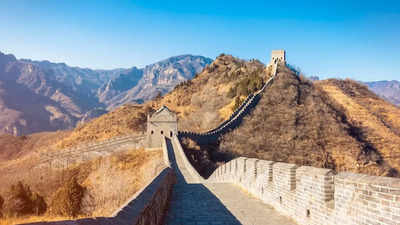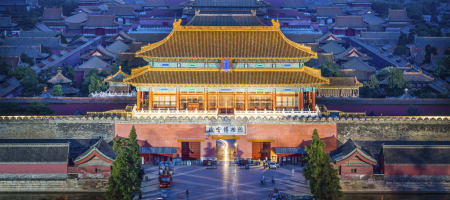Forbidden City
Forbidden City: A Majestic Landmark in the Heart of Beijing
Introduction
Beijing, the capital city of China, is renowned for its rich history and cultural heritage. Amongst its numerous landmarks, the Forbidden City stands out as one of the most beautiful and significant historical sites. With its breath-taking architecture, intricate details, and intriguing historical background, it epitomizes grandeur and magnificence.
Unveiling the Secrets: What is the Forbidden City?
The Forbidden City, known as "Zǐjìnchéng" (紫禁城) in Chinese, can be traced back to ancient times. Constructed during Ming Dynasty's Emperor Chengzu's reign from 1406 to 1420 AD., this remarkable complex served as an imperial palace for over five centuries. Located at the heart of Beijing, it was home to emperors from both the Ming and Qing dynasties.
The name “Forbidden City” springs from a long-standing tradition that forbade commoners' access to this regal enclave without royal permission—a testament to its unique status even then.
Architecture: A Stunning Display of Imperial Grandeur
One cannot help but marvel at the architectural prowess on display within every inch of The Forbidden City. With more than 180 acres encompassing countless palaces, halls, pavilions along with meticulously designed gardens - every corner holds captivating stories waiting to be unraveled.
Key Features
- Intricate Palace Layout:
- Comprising over 980 buildings arranged harmoniously across multiple courtyards.
-
Hallmarks include Meridian Gate (午门), Hall of Supreme Harmony (太和殿), Hall of Central Harmony (中和殿), Hallmarks such as Meridian Gate, Hallmarks such as featuring magnificent thrones thrones where ceremonies were held.
-
Exquisite Decorative Details:
- The intricate carvings on the wooden beams, pillars and palace walls showcase the impressive craftsmanship of that era.
-
Elaborate dragon motifs, vibrant colors, and traditional Chinese symbols adorn every structure.
-
Imperial Gardens:
- Beyond the halls lies a serene escape—a carefully landscaped garden complete with terraces, ponds, and ancient trees.
- These tranquil spots served as retreats for emperors to refresh their minds amidst busy political affairs.
A Step into History: Past Glory and Significance
Delving into history within this splendid architectural masterpiece reveals a multitude of stories filled with grandeur, power struggles, traditions, and ambitions. Each room preserves remnants of its glorious past.
Historical Significance
-
Symbol of Power: Serving as an imperial residence for over five centuries reinforced its position as China's center of authority during both Ming and Qing dynasties.
-
Cultural Legacy: It embodies traditional Chinese architecture and aesthetics – acting as a living testament to thousands of years' worth of cultural heritage.
-
Preservation Efforts: Recognizing its historical value globally (recognizing), UNESCO designated designation it as a World Heritage Site in 1987; since then,* extensive restoration projects have been undertaken to maintain its splendor.
Critically Acclaiming Forbidden City – Objective Perspective
While undoubtedly awe-inspiring from various angles,forming various perspectives **(*)-and boasting remarkable charm,* one cannot dismiss certain notable drawbacks associated with such prominent landmarks:
-
Crowds & Accessibility Challenges:
-
Limited Interpretation & Engagement Opportunities:
-
Lingering Controversy around Acquisition:
Despite these legitimate concerns though ((though)) , The Forbidden City remains ingrained deeply within Beijing's cultural fabric—a must-visit(*)(for all visitors).
Conclusion
In conclusion,The iconic Forbidden City stands tall and proud within the heart of Beijing, representing the pinnacle of Chinese architectural brilliance and historical significance. It offers a glimpse into a bygone era, captivating visitors from all corners of the globe with its rich tales. (richly). From its majestic layout to intricate decorative details, it stands as a testament to China's cultural heritage.
So if you're planning on exploring Beijing's glorious landmarks, make sure to put the Forbidden City at the top of your itinerary—enhancing your trip with an unrivaled dose of historical magnificence.!
Great Wall of China

The Great Wall of China: An Enduring Icon of Beauty
Introduction
The Great Wall of China is undeniably one of the most remarkable landmarks in Beijing, captivating visitors with its sheer grandeur and awe-inspiring beauty. Stretching over 13,000 miles across rugged terrains, this ancient marvel stands as a testament to human ingenuity and determination. Its historical significance combined with the striking natural landscapes it traverses make it an undeniable contender for one of the top three most beautiful landmarks in Beijing.
A Testament to Human Ingenuity
The architectural brilliance
"The greatness of a nation can be judged by how well it treats its heritage." - Mahatma Gandhi
Dating back more than 2,000 years, the construction of the Great Wall was an extraordinary feat achieved by millions who labored tirelessly under often challenging conditions. This sprawling structure winds through mountains, valleys, and deserts – a tribute to human engineering prowess.
Diverse architectural styles
The Jinshanling section showcases imposing battlements that stand proudly against a picturesque landscape adorned with lush greenery. Visiting this section allows travelers to witness nature's embrace around history's enduring walls.
An alternative experience awaits at Mutianyu, where visitors are greeted by watchtowers perched high on mountain ridges. Here you can revel in stunning panoramic views amidst abundant foliage painting vivid hues throughout all four seasons.
Nature's Harmonious Embrace
A photographer's delight
As sunlight bathes segments of the wall nestled amongst rolling hills or shrouded in mist atop majestic peaks during dawn or dusk hours; photography enthusiasts will find themselves spoilt for choice regarding capturing breathtaking moments immersed within nature's generous splendor.
Fall foliage reveals hidden charm
During autumn months (September-November), vibrant shades envelop nearby forests transforming this iconic monument into an ethereal masterpiece resembling strokes from an artist's brush. Scarlet red, golden yellow, and burnt orange leaves present an ideal backdrop for fascination blending harmoniously between the man-made structure and its natural surroundings.
A Historical Time Capsule
Guardian against invaders
The Great Wall of China has served as a formidable barrier, shielding ancient dynasties from countless invasions by nomadic tribes hailing from Mongolia or Siberia. Its magnificence symbolizes both the defense strategy devised to protect an empire and the historical significance it holds within Chinese culture.
A living testament to national identity
With each brick laid eons ago still standing strong today, this landmark depicts centuries of fascinating history embedded within its stones. Visitors can't help but feel captivated by stories whispered through time as they walk along these ancient pathways, connecting with a past that shaped China into what it is today.
Conclusion
The Great Wall of China reigns supreme among Beijing's most beautiful landmarks for good reason; more than just a physical structure, it embodies humanity's resilience and reverberates with narratives spanning generations. As one stands atop breathtaking watchtowers or wanders through rugged terrain accompanied by whispers echoing throughout its history-rich walls, the sheer beauty encompassing this iconic monument instills awe-inspiring emotions that are impossible to replicate elsewhere in the world.
Despite minor areas where maintenance could improve overall visitor experience or limited accessibility on certain remote sections due to natural wear over time,1 these considerations pale in comparison when confronted with Mother Nature's seamless integration alongside human architectural triumphs. The Great Wall remains forever etched in our collective consciousness as an enduring icon uniting beauty and historical significance perfectly encapsulating Beijing's allure.
—--—
"Visiting the Great Wall was an unforgettable experience! The breathtaking views combined with learning about its rich history made me appreciate not only Beijing but also the remarkable achievements of mankind." - A Traveler's Testimonial2
—--—
References
Summer Palace
The Enchanting Summer Palace: A Gem in Beijing's Crown
Introduction
Beijing, the vibrant capital of China, boasts a rich cultural heritage and is home to some of the world's most stunning landmarks. Among these, one name reigns supreme – the exquisite Summer Palace. As we explore the topic of "Top 3 Most Beautiful Landmarks in Beijing," it becomes abundantly clear that this iconic landmark deserves its place among the elite. Let us take a closer look at what makes this palace truly mesmerizing.
History and Significance
The Summer Palace, known locally as Yiheyuan, was originally built during the Jin dynasty (1153 AD) but underwent reconstructions throughout subsequent dynasties. Its history can be traced back over 800 years when it first served as a retreat for royal families seeking respite from Beijing's scorching summer heat.
-
A Haven for Emperors: Over time, successive emperors expanded and embellished this grand imperial garden until it became a sprawling masterpiece on an unimaginable scale.
-
Symbolic Architectural Marvels: Homage to Chinese literature permeates every corner of the palace grounds. From intricate Buddhist grottoes to elaborate painted ceilings depicting ancient tales from folklore like "The Journey to the West," each structure tells its fascinating story.
-
UNESCO World Heritage Site: Recognizing its historical importance and breathtaking beauty, UNESCO declared the Summer Palace as a World Heritage site in 1998—a testament to its unmatched significance on both national and international levels.
An Exquisite Blend of Nature and Architecture
Spanning an astonishing area of 2.9 square kilometers (720 acres), with roughly three-quarters occupied by water bodies such as Kunming Lake—the largest lake within any Chinese imperial garden—it is no wonder why nature enthusiasts flock here year-round.
Grand Palaces
Standing tall amidst lush greenery are the magnificent palaces – structures that encapsulate both opulence and elegance. The Hall of Benevolence and Longevity (Renshoudian) is where emperors held important ceremonies, while the lavish Court of Virtuous Consort (Deheyuan) served as a residence for Empress Dowager Cixi.
Seventeen-Arch Bridge
Leading visitors across Kunming Lake is the famous Seventeen-Arch Bridge. Admired for its harmonious integration with natural surroundings, this picturesque stone bridge has been an enduring symbol of Chinese architectural ingenuity since its completion in 1764.
Long Corridor
Connecting various pavilions throughout the Summer Palace stands another impressive feature—the Long Corridor. Stretching over 728 meters, this covered walkway mesmerizes visitors with more than 14,000 intricately painted images depicting vibrant scenes from Chinese mythology and historical events.
A Testimony to Chinese Gardens
The Summer Palace showcases imperial gardens at their zenith. Inspired by renowned landmarks like West Lake in Hangzhou, these meticulously landscaped havens are masterworks of symmetry and harmony.
-
Longevity Hill rises dramatically from Kunming Lake's shores, adorned with traditional ceremonial halls and stunning pagodas—each built to perfection.
-
Gardens Galore: Wander through enchanting landscapes such as Garden of Harmonious Pleasures (Yiheyuan), Garden for Cultivating Harmony (Chisuiyuan), or watch vibrant lotus flowers bloom at Lotus Fragrance Island — every twist and turn holds surprises waiting to be discovered!
-
Winding Paths & Tranquil Reflections: Stroll along winding paths that lead you past ancient trees reflecting vividly upon serene waters. Undeniably relaxing yet stimulating to wanderers' spirits—a tranquility unparalleled among Beijing's bustling city life.
Conclusion
The Summer Palace effortlessly captures China's imperial grandeur within a breathtaking natural landscape. Its cultural significance, architectural brilliance, and serene grounds make it an unmissable gem for tourists and locals alike.
With its well-deserved position as one of the "Top 3 Most Beautiful Landmarks in Beijing," this majestic retreat stands testament to China's rich history and artistry. To visit the Summer Palace is to uncover the immense beauty that lies within Beijing's ancient heart—each step imbued with a sense of wonder and awe.
So, whether you crave a glimpse into imperial life or simply wish to immerse yourself in stunning scenery, make sure that experiencing the Summer Palace finds its way onto your bucket list—it will leave an everlasting impression on all who venture through its hallowed gates.!


no comments